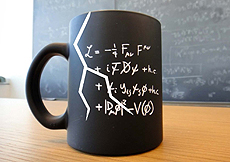New theories for new physics
 |
| The Standard Model of particle physics can be summarized on a coffee mug. Theorists predict where cracks in this framework may start showing up. Image courtesy of Quantum Diaries
|
Scientists use data from the Large Hadron Collider to measure the properties of the Standard Model at higher energies than ever before. While this allows us to confirm that our theory of the world works as expected in a new regime, everyone involved really hopes to see this theory break.
Discovering new particles or new principles is the aim of these large experiments. To do so requires not only knowing the predictions of the Standard Model very well and measuring the outcome of collisions very precisely, but also understanding the ways that deviations are likely to show up and which observables can probe them. This is the focus of theorists that work on physics beyond the Standard Model.
The recent discovery of the Higgs boson has completed the Standard Model on the one hand, but it has given us a new opportunity to search for Beyond the Standard Model physics on the other. The Standard Model framework makes exact predictions for the properties of the Higgs. Any observed deviation from these predictions would signal a breaking of this framework and indicate the existence new physics. The nature and size of such a deviation would give important clues as to the nature and scale of new particles.
One possibility not allowed in the Standard Model is that the interactions of the Higgs boson would violate a particle property called flavor. This would mean, for example, that a Higgs boson could simultaneously interact with two particles of different families, perhaps decaying into a muon and a positron. (The stronger the interaction, the more likely it is for these particles either to form or decay from a Higgs and the greater its so-called coupling constant.)
Current and former members of Fermilab's Theory Group have explored the limits on and future opportunities to discover such interactions both at the LHC and with low-energy tests. One such opportunity would arrive with the start of the upcoming Mu2e experiment at Fermilab. We have found that Mu2e would be able to probe Higgs decays into a muon and an electron with an extremely small interaction strength, one with a coupling constant of 10-6 or 10-7. This coupling strength is even weaker than the weakest interaction of the Higgs in the Standard Model.
Furthermore, the LHC experiments can search for Higgs decays into a muon and a tau and be sensitive to the corresponding Higgs interaction at the 10-2 level. Motivated by the work of these Fermilab theorists, LHC scientists are currently conducting these searches for these decays.
We all hope that the Higgs is just the beginning of the new discoveries at the LHC and that we will see the Standard Model break in numerous ways. There are strong reasons to believe that the Standard Model is not the final answer. But how Beyond the Standard Model theory completes the Standard Model is unknown. The Fermilab Theory Group is actively researching many ideas, such as supersymmetry, extra dimensions and strongly coupled theories, but space does not permit the discussion of them all. For those who wish to learn more or have evidence of the Standard Model breaking, please stop by the third floor of Wilson Hall!
—Patrick Fox and Roni Harnik
|